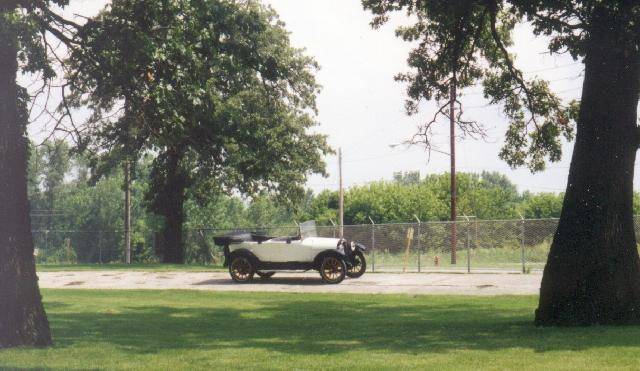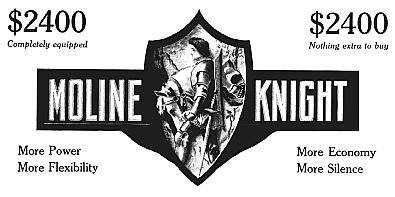
1916 Moline Knight on the original test track.
 The Knight engine was adopted after almost a year of extensive testing.
Having satisfied themselves of the Knight engines superiority, a Moline
Knight engine was publicly tested in a non stop test by the Automobile
Club of America. It ran 337 hours without adjustment to motor, magneto,
spark plugs or carburetor in this two week public test. Company advertising
claimed that Charles Knight was happy to grant the Moline Auto Co. a licence
to build his engine because along with their nine years successful experience
as motor car producers they had fourteen years experience as builders of
gasoline engines - with R&V engine output said to be over 20,000 per
year !
The Knight engine was adopted after almost a year of extensive testing.
Having satisfied themselves of the Knight engines superiority, a Moline
Knight engine was publicly tested in a non stop test by the Automobile
Club of America. It ran 337 hours without adjustment to motor, magneto,
spark plugs or carburetor in this two week public test. Company advertising
claimed that Charles Knight was happy to grant the Moline Auto Co. a licence
to build his engine because along with their nine years successful experience
as motor car producers they had fourteen years experience as builders of
gasoline engines - with R&V engine output said to be over 20,000 per
year !
The Moline Automobile Co. name was changed in 1918 to the Root and
VerDerVoort Engineering Company and the Moline Knight gave way to the R&V
Knight for the 1920 Market. Like it predecessors, it was a quality
car throughout and carried a price tag similar to Cadillac.
The R&V Knight was a 6 cylinder with a distinctive V type radiator
and $4,000 price tag on its closed models. In 1921 the prices of
the sixes were increased to make way for a 4 cylinder R&V Knight.
1922 marked the peak of production with 1300 vehicles produced. In
1923 the six cylinder model was released with a flat radiator with engines
now being built by the Yellow Sleeve Valve Engine Works.
By December of 1924, the R&V Motor Company gave up its automobile
production and instead concentrated on building truck and bus engines.
The remains of about a third of the old Moline Automobile Co. test
track still exists at the AMETEK plant in East Moline.

1916 Moline Knight on the original test track.
Interested readers should also refer to W.O.K.R. STARTER number 127, Apr - Jun 1994 as well as the W.O.K.R. LIBRARY for more information on the Moline / R&V family of vehicles.
Enthusiasts should also make contact with the
Moline, Moline-Knight, and R&V-Knight Automobile Registry
John Nikodym
1111 Highway 281
Red Cloud, NE 68970
email nikrcne@gpcom.net
402-746-2248
For those specifically interested in Root & VanDerVoort Engines, an International Register can be found at http://www.oldengine.org/members/plowe/rv-engines/rvpage.htm